Mind That Until Now Thought of Continuity, Our Torch, Then Saw It Flicker (The Last War in Albion Book Two Part Thirty-One: The Marriage of Heaven and Hell)
Previously in The Last War in Albion: The War was revealed to have certain similarities to the life and work of William Blake, whose mythology was built around the dualism of the creator Los and the tyrannical geometer Urizen.
 |
| Figure 954: Los recoils in horror from his work as Urizen’s body assembles itself. (By William Blake, from The Book of Urizen Copy G, written 1794, printed 1818) |
As Blake’s dualism suggests, his instinctive mode of resistance to Urizen, both within himself and without, was creation. Specifically, in Blake’s case, the creation of art. As The Book of Urizen itself makes clear by depicting Los’s failure, the point is not that this resistance will “stop” or “defeat” Urizen, or indeed any other figure one wishes to inveigh against. Indeed, the point is often simply a matter of need or compulsion. Much like Watchmen is simply not a thing one writes if one is capable of avoiding doing so, the ornately realized illuminated prophecies that Blake creates – especially the late career ones such as the fifty page Milton a Poem and the hundred page Jerusalem the Emanation of the Giant Albion – are not works that people create incidentally. In many ways, this is far more true for Blake than for Moore. Moore, after all, may not have been capable of stopping himself from writing Watchmen, but equally, he wouldn’t have written it were it not for the existence of a major comics company that wanted him to do a prestige project. It was a lucrative gig and, for all Moore’s eventual misgivings about it, a savvily chosen project. Blake’s work, on the other hand, was ostentatiously non-commercial. The illuminated prophecies used printing techniques of his own devising, not fitting into any existing market or practice. After an early flirtation with the relatively sellable notion of a children’s book of poetry in the form of Songs of Innocence, his illuminated work moved quickly and decisively towards the obscure and difficult. His insistence that each copy must be unique and of his hand severely limited sales. In short, Blake’s illuminated prophecies eschewed essentially every form of commercial sense known to man.
_p18_(comichost-dcp).jpg) This is not to say that Blake lacked all business sense. He supplemented his work as a prophet with more conventional commercial illustration, thus generally managing to make ends meet, although it was at times a bitterly narrow thing. But Blake often resented this work, and the degree to which he was constantly haunted by paranoia about his friends and associates made things harder for him. As a result, he could turn on his employers, as he did with his patron at the start of the 19th century, William Hayley, who gave him lodging in a cottage at Felpham and a series of portrait commissions that kept him busy and well paid. He found the work deadening, however, eventually coming to describe Hayley as “an enemy of my spiritual life” and moving back to London, where he quickly started work on Milton and Jerusalem.…
This is not to say that Blake lacked all business sense. He supplemented his work as a prophet with more conventional commercial illustration, thus generally managing to make ends meet, although it was at times a bitterly narrow thing. But Blake often resented this work, and the degree to which he was constantly haunted by paranoia about his friends and associates made things harder for him. As a result, he could turn on his employers, as he did with his patron at the start of the 19th century, William Hayley, who gave him lodging in a cottage at Felpham and a series of portrait commissions that kept him busy and well paid. He found the work deadening, however, eventually coming to describe Hayley as “an enemy of my spiritual life” and moving back to London, where he quickly started work on Milton and Jerusalem.…


_(comichost-dcp)_p002.jpg)
_p12_(comichost-dcp).jpg) bonkers plot involving faking an alien invasion with a giant squid monster designed by a committee
bonkers plot involving faking an alien invasion with a giant squid monster designed by a committee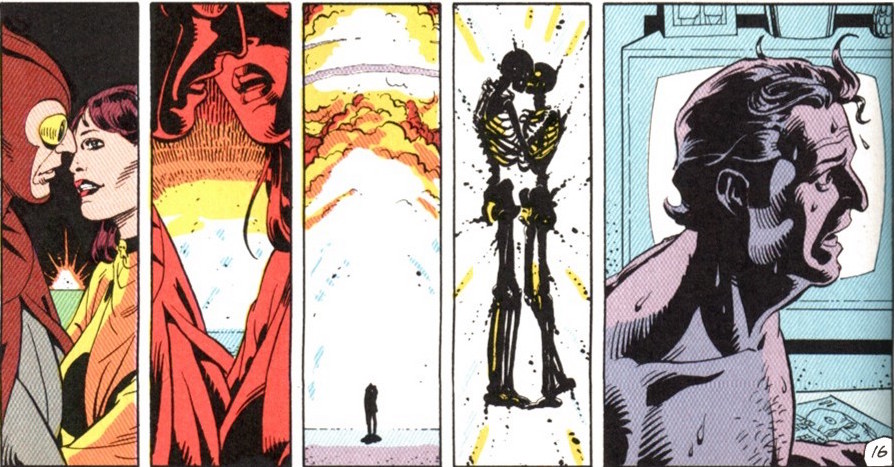
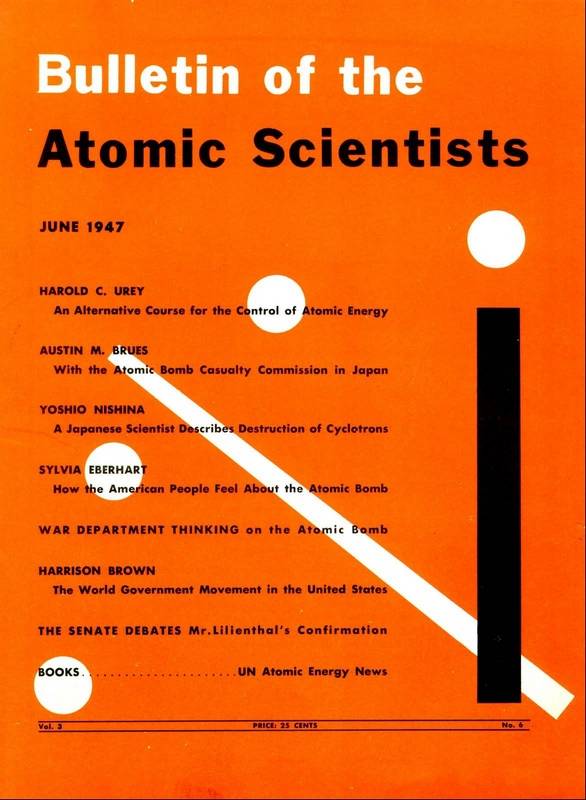
_p01_(comichost-dcp).jpg) Moore’s disorientation and confusion in the wake of Watchmen is wholly understandable. Even reading Watchmen is, at times, enough to generate a sense of dazed exhaustion. And this is very much the point – an effect consciously generated by Moore’s use of the dense uniformity of the nine-panel grid. As Kieron Gillen puts it in Kieron Gillen Talks Watchmen, “if we’re talking about the many icons of Watchmen, [the nine-panel grid] is the invisible one. It underlies everything. We’re to watch these little boxes – hundreds of them – and make sense by combining them all into a larger piece of meaning. Watch,” he says, and snaps his fingers to cue his projectionist to advance his PowerPoint to a shot of Ozymandias watching his wall of television screens. Gillen talks about the comic as a “clockwork machine” in which “everything is predetermined. The forces that are put into motion mean this… the clock will carry on ticking, and if you read Watchmen enough you’ll know what the next tick is.” Gillen, here, is talking about the comic’s famously ambiguous ending, making a strong case that in fact there is only one possible “next step” for the book to take, and that the inevitable momentum of that step hangs impermeably over the entire work, which is in turn what Morrison speaks of when he talks about how the god of Watchmen is always shoving his cock in the reader’s face.
Moore’s disorientation and confusion in the wake of Watchmen is wholly understandable. Even reading Watchmen is, at times, enough to generate a sense of dazed exhaustion. And this is very much the point – an effect consciously generated by Moore’s use of the dense uniformity of the nine-panel grid. As Kieron Gillen puts it in Kieron Gillen Talks Watchmen, “if we’re talking about the many icons of Watchmen, [the nine-panel grid] is the invisible one. It underlies everything. We’re to watch these little boxes – hundreds of them – and make sense by combining them all into a larger piece of meaning. Watch,” he says, and snaps his fingers to cue his projectionist to advance his PowerPoint to a shot of Ozymandias watching his wall of television screens. Gillen talks about the comic as a “clockwork machine” in which “everything is predetermined. The forces that are put into motion mean this… the clock will carry on ticking, and if you read Watchmen enough you’ll know what the next tick is.” Gillen, here, is talking about the comic’s famously ambiguous ending, making a strong case that in fact there is only one possible “next step” for the book to take, and that the inevitable momentum of that step hangs impermeably over the entire work, which is in turn what Morrison speaks of when he talks about how the god of Watchmen is always shoving his cock in the reader’s face._p00_(comichost-dcp).jpg)
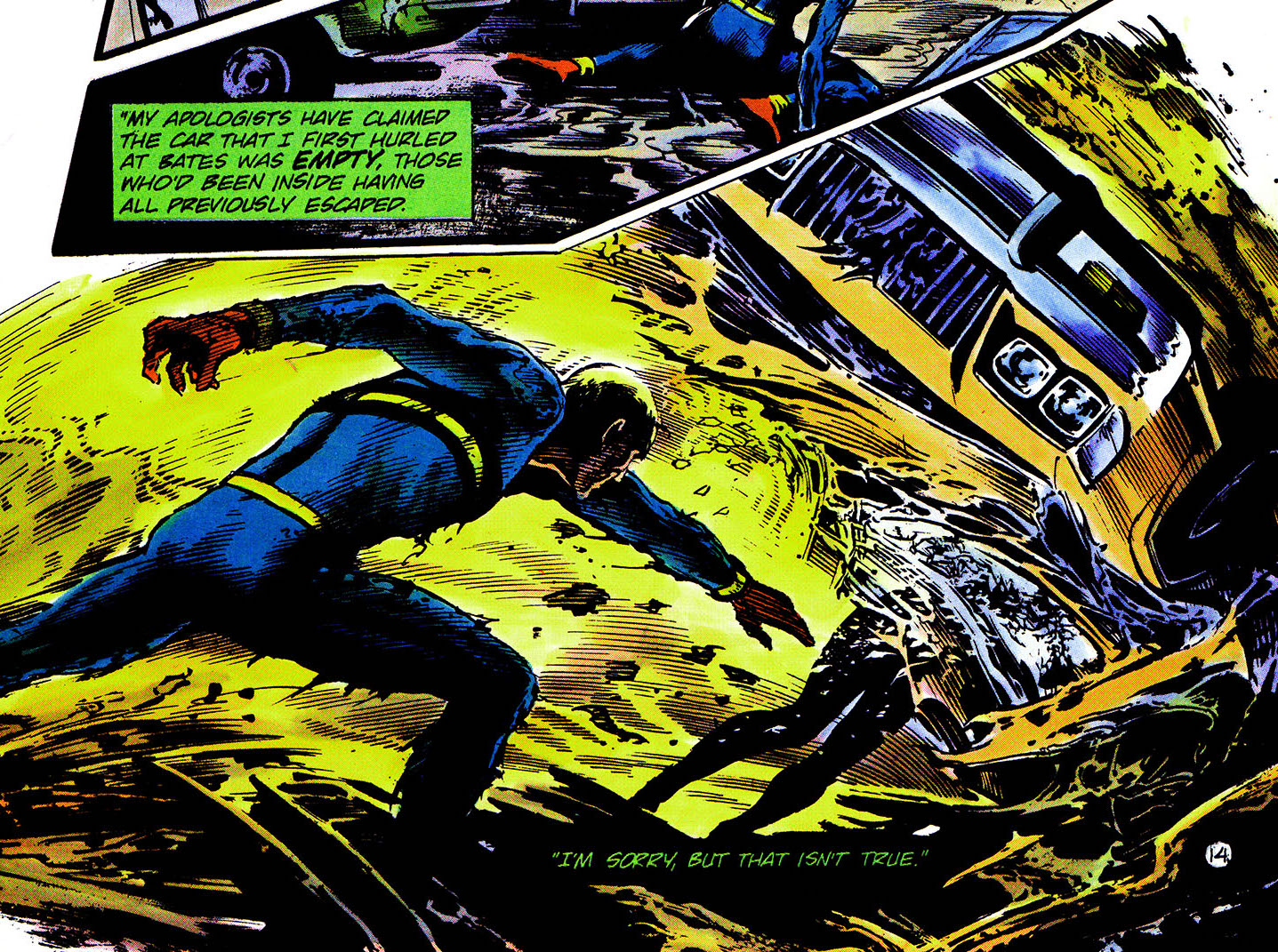
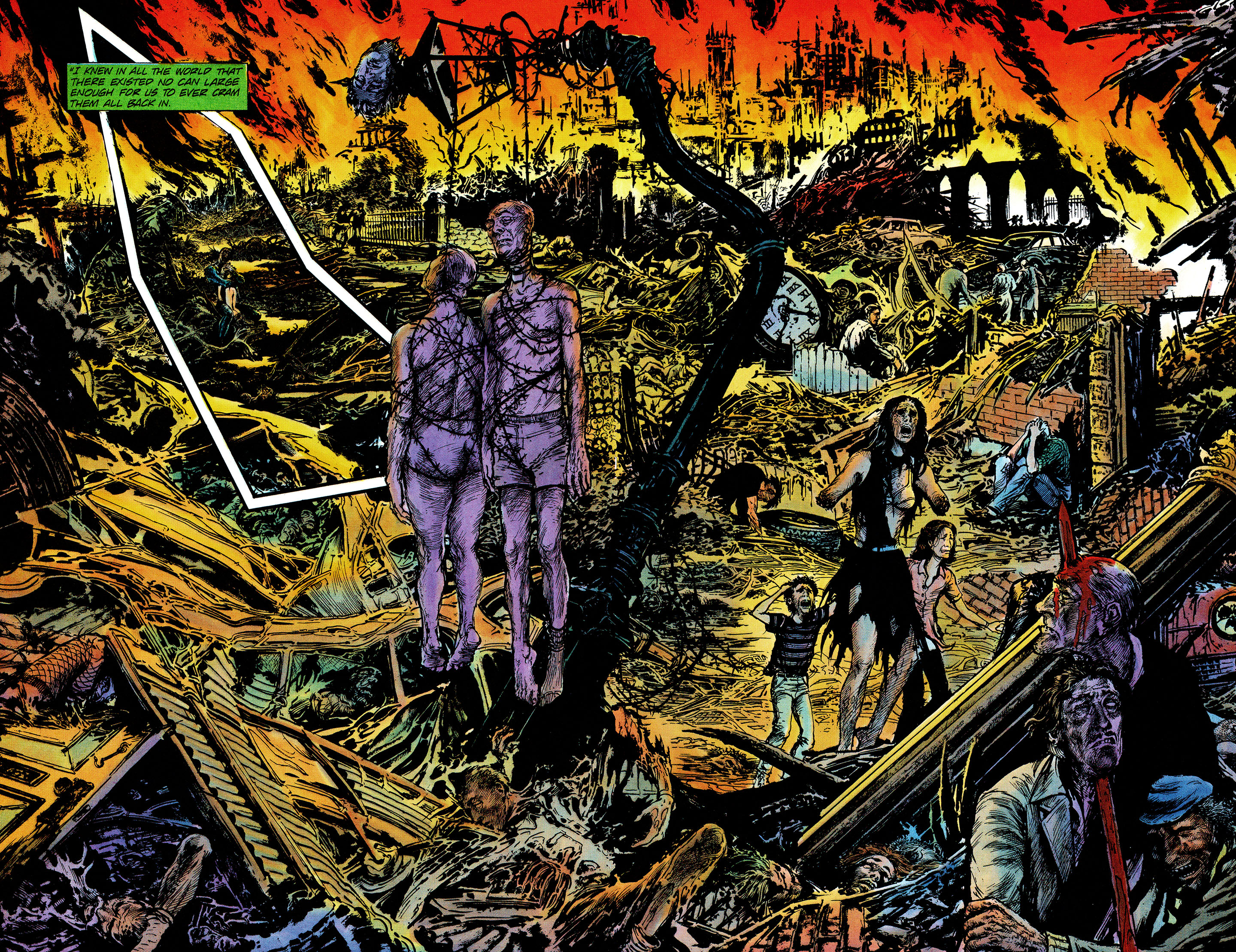
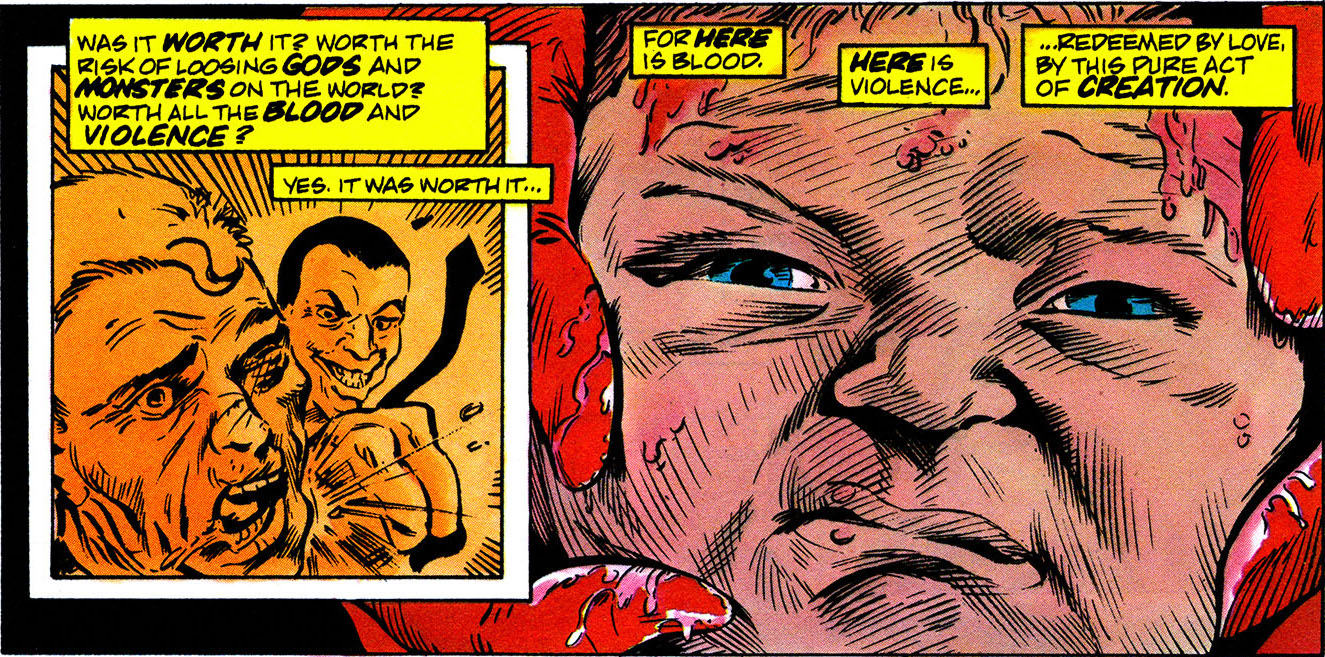
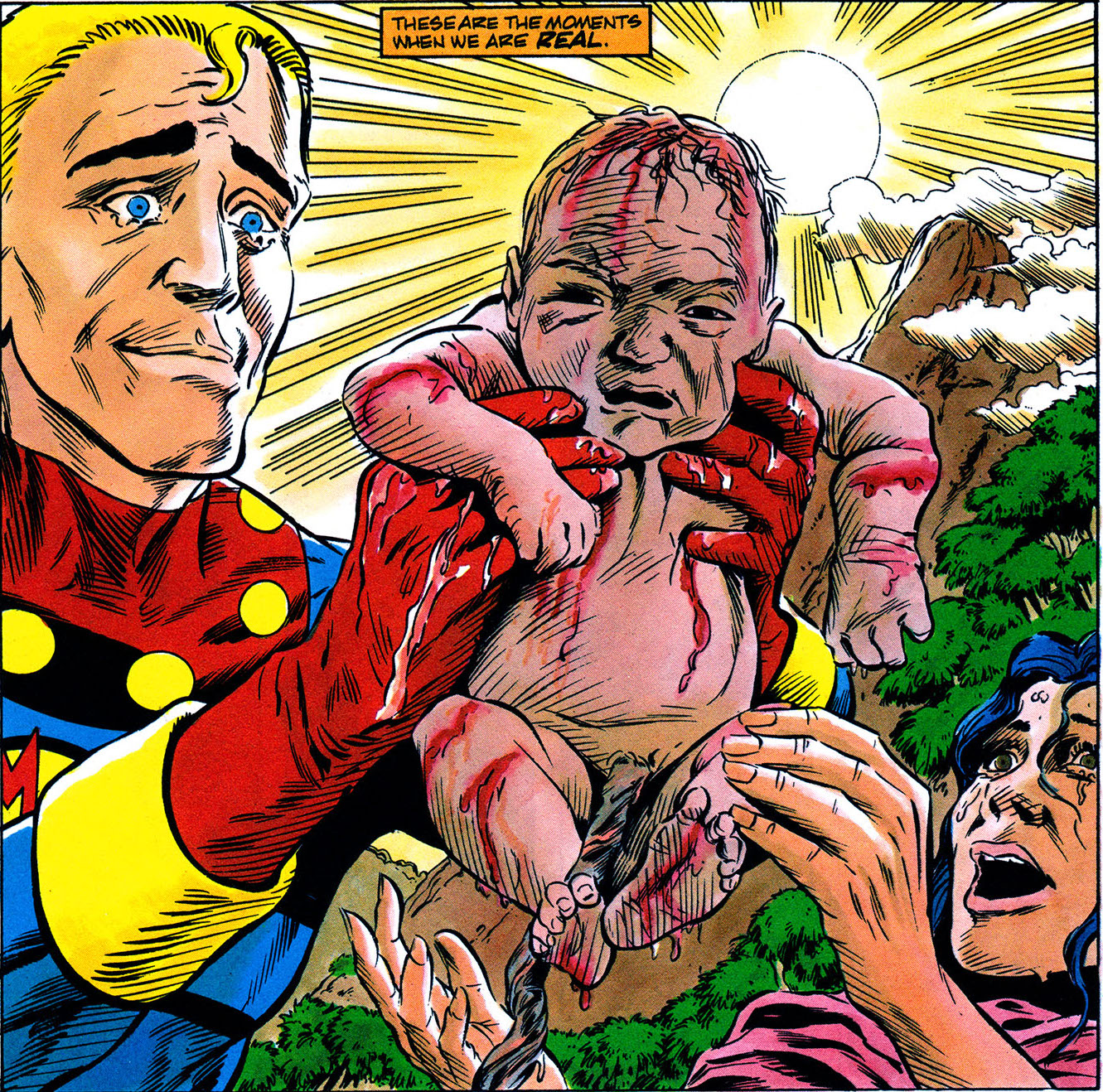
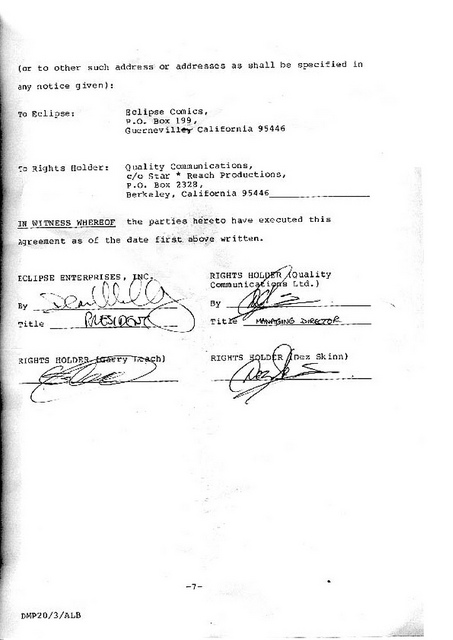
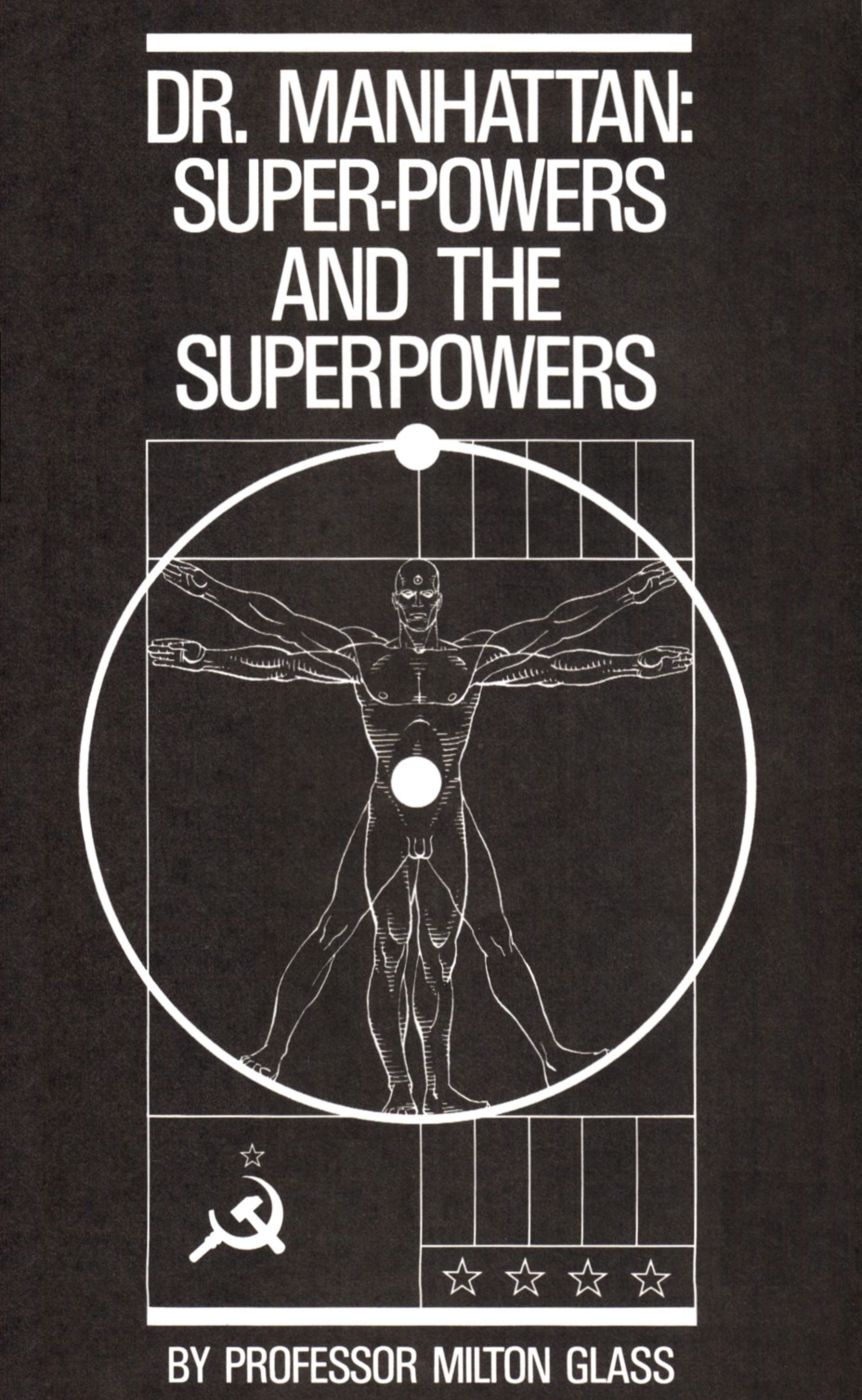 {Impressively, Alan Moore’s second publisher for Marvelman/Miracleman was an even bigger trainwreck than his first. It is perhaps unsurprising, given this, to find out that Dez Skinn negotiated the bulk of the deal. The financial plan for Warrior had always involved selling the strips to foreign markets, and Skinn was determined to sell them as a package, reasoning that “strips like Spiral Path – which I put into an anthology alongside Shandor and Bojeffries Saga – were not the stars of the show,” but that Warrior would never have happened without them and that they deserved the same shot at foreign publication as the heavy-hitters like V for Vendetta and Laser Eraser and Pressbutton. But ironically, it wasn’t the lesser Warrior material that made selling the strips abroad a challenge, but the nominal crown jewel, Marvelman, as neither of the two biggest comics publishers would touch it. DC was the obvious first choice, since they were already having considerable success publishing Alan Moore in the US market, and were indeed interested, but Dick Giordano pointed out that there was simply no way that they could publish a comic called Marvelman, citing the number of problems they were already having with Captain Marvel, which they’d bought from the smoldering ruins of Fawcett and started publishing under the name Shazam! But the obvious second choice proved no better; Marvel wouldn’t touch it either, pointing out that if they were to publish a strip called Marvelman it would be read as representing the entire company, which was perhaps not quite what they wanted Moore’s psychologically damaged take on superheroes to do.
{Impressively, Alan Moore’s second publisher for Marvelman/Miracleman was an even bigger trainwreck than his first. It is perhaps unsurprising, given this, to find out that Dez Skinn negotiated the bulk of the deal. The financial plan for Warrior had always involved selling the strips to foreign markets, and Skinn was determined to sell them as a package, reasoning that “strips like Spiral Path – which I put into an anthology alongside Shandor and Bojeffries Saga – were not the stars of the show,” but that Warrior would never have happened without them and that they deserved the same shot at foreign publication as the heavy-hitters like V for Vendetta and Laser Eraser and Pressbutton. But ironically, it wasn’t the lesser Warrior material that made selling the strips abroad a challenge, but the nominal crown jewel, Marvelman, as neither of the two biggest comics publishers would touch it. DC was the obvious first choice, since they were already having considerable success publishing Alan Moore in the US market, and were indeed interested, but Dick Giordano pointed out that there was simply no way that they could publish a comic called Marvelman, citing the number of problems they were already having with Captain Marvel, which they’d bought from the smoldering ruins of Fawcett and started publishing under the name Shazam! But the obvious second choice proved no better; Marvel wouldn’t touch it either, pointing out that if they were to publish a strip called Marvelman it would be read as representing the entire company, which was perhaps not quite what they wanted Moore’s psychologically damaged take on superheroes to do.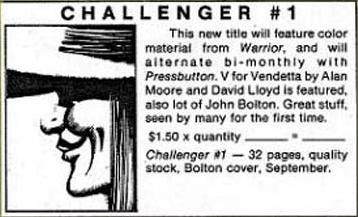
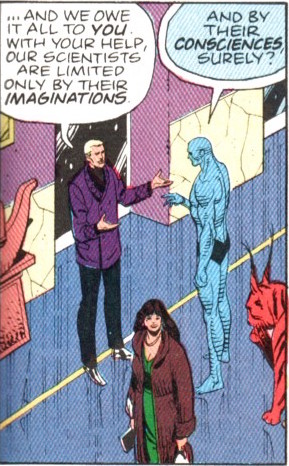 It is October 1987. Moore is sitting down to dinner after a Glasgow signing to promote Watchmen. At the table is Grant Morrison, a neophyte comics writer. It is the only meeting between them that Moore recalls, although he had given Morrison advice at a 1983 Glasgow comic mart when Morrison was on the cusp of transitioning from a failed rock star to a successful comics writer. Moore will eventually, to Morrison’s chagrin, describe him as an “aspiring” comics writer at the time of this meeting, one of many swipes he will take at Morrison over the years. They talk about vegetarianism. (“Sometimes you can’t live with the contradictions, Grant,” Morrison recalls him saying.)
It is October 1987. Moore is sitting down to dinner after a Glasgow signing to promote Watchmen. At the table is Grant Morrison, a neophyte comics writer. It is the only meeting between them that Moore recalls, although he had given Morrison advice at a 1983 Glasgow comic mart when Morrison was on the cusp of transitioning from a failed rock star to a successful comics writer. Moore will eventually, to Morrison’s chagrin, describe him as an “aspiring” comics writer at the time of this meeting, one of many swipes he will take at Morrison over the years. They talk about vegetarianism. (“Sometimes you can’t live with the contradictions, Grant,” Morrison recalls him saying.)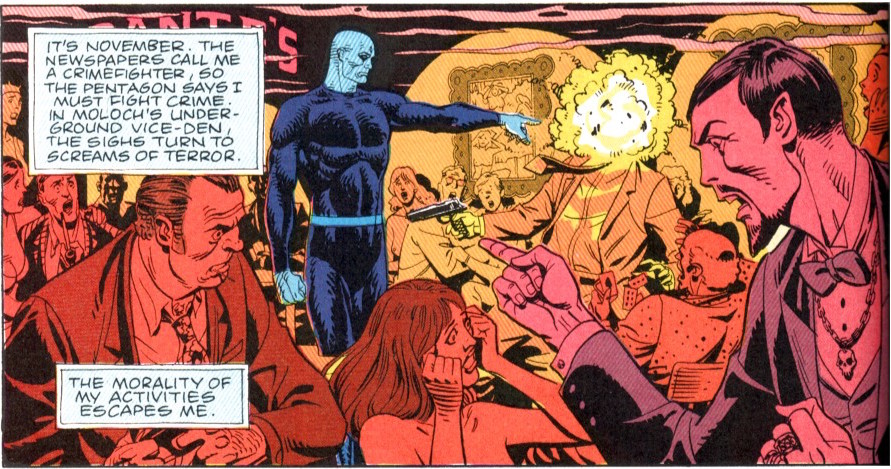 It’s summer, 1992. Alan Moore is thirty-eight. Just a few years out from the twin smoldering wreckages of Big Numbers and his first marriage, he takes a call from Jim Valentino at Image Comics. Moore is unimpressed with the Image output, thinking, “I’ve been away for five years, and comics have turned into some bizarre super-steroid-mutant hybrid that I’ve got no familiarity with at all,” but the business model of Image appeals to him, and the failure of Big Numbers along with a relatively fallow period in Moore’s output means he needs the money, and so he throws himself into “teaching myself this new language and trying to understand this new audience.” He ends up creating 1963 with Steve Bissette and Rick Veitch, a colorful pastiche of vintage Marvel comics written in explicit contrast to the post-Watchmen style (largely embodied by Image itself) of violent and cynical comics.
It’s summer, 1992. Alan Moore is thirty-eight. Just a few years out from the twin smoldering wreckages of Big Numbers and his first marriage, he takes a call from Jim Valentino at Image Comics. Moore is unimpressed with the Image output, thinking, “I’ve been away for five years, and comics have turned into some bizarre super-steroid-mutant hybrid that I’ve got no familiarity with at all,” but the business model of Image appeals to him, and the failure of Big Numbers along with a relatively fallow period in Moore’s output means he needs the money, and so he throws himself into “teaching myself this new language and trying to understand this new audience.” He ends up creating 1963 with Steve Bissette and Rick Veitch, a colorful pastiche of vintage Marvel comics written in explicit contrast to the post-Watchmen style (largely embodied by Image itself) of violent and cynical comics.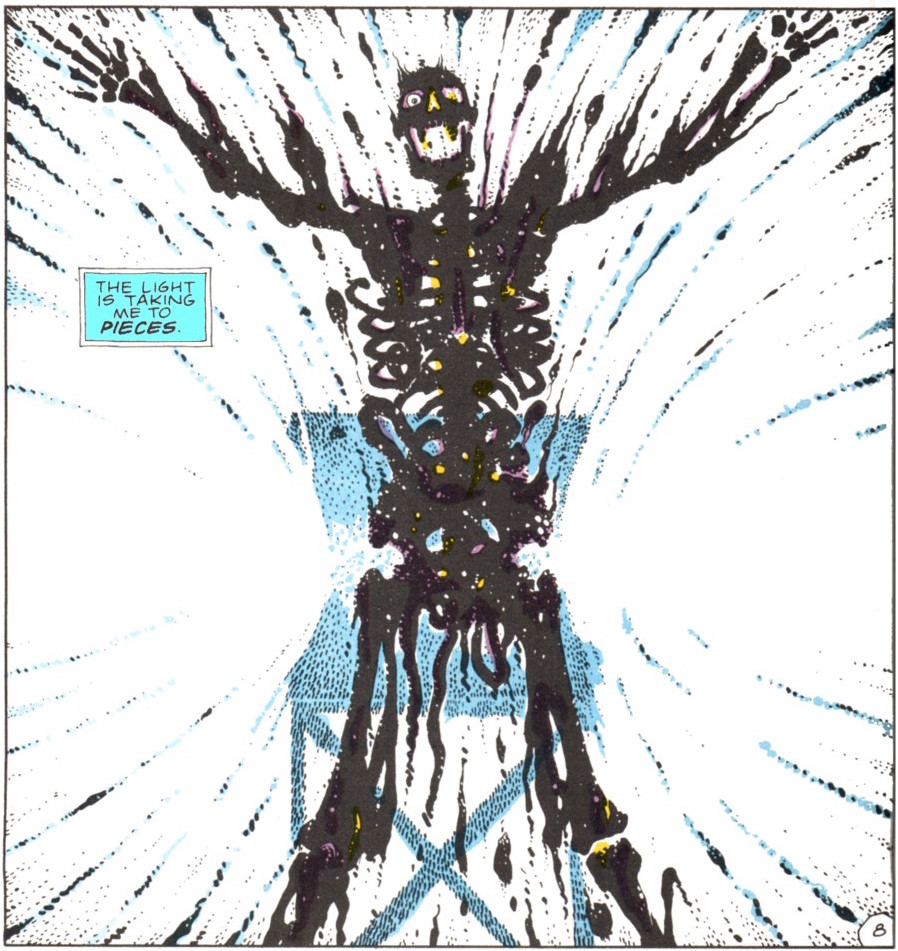 It’s January 7
It’s January 7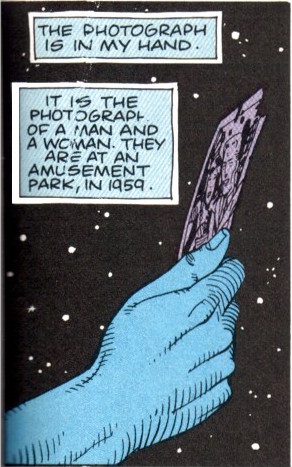 It is January, 1988. Alan Moore is thirty-three, and writing the introduction to the collected edition of Watchmen. His relationship with the publisher is in tatters, a fact he alludes to only vaguely when he notes that it is “the very last work that I expect to be doing upon Watchmen for the foreseeable future.” He looks back to 1984, when the idea originated, and the giddy enthusiasm of it all. And yet there is something he cannot quite locate in this. He notes that at the start “we wanted to do a novel and unusual super-hero comic that allowed us the opportunity to try out a few new storytelling ideas along the way. What we ended up with was substantially more than that.” But he cannot pin down the transition. Instead he describes a growing realization of the story’s complexity and scale, but without a sense that the realization had an end point. Instead, “there was the mounting suspicion (at least on my part) that we might have bitten off more than we could chew, that we might not be able to resolve all these momentous strands of narrative and meaning that seemed to be springing up wherever we looked, that we might be left at the end of the day with a big, messy, steaming bowl of semiotic spaghetti.” But even when the project ended. But even now, in 1988, Moore is lost in the process, saying that it is only now, in writing the introduction, that he realizes “how dazed a state I’d spent that year in, as if I’d been slam dancing with a bunch of rhinos and the concussion was only just starting to clear up,” a claim that oddly undercuts itself; the daze clearly extending beyond the year, simultaneously located “now, twelve months after” he finished the final script and in the past, as indicated by the past tense in the concussion metaphor.
It is January, 1988. Alan Moore is thirty-three, and writing the introduction to the collected edition of Watchmen. His relationship with the publisher is in tatters, a fact he alludes to only vaguely when he notes that it is “the very last work that I expect to be doing upon Watchmen for the foreseeable future.” He looks back to 1984, when the idea originated, and the giddy enthusiasm of it all. And yet there is something he cannot quite locate in this. He notes that at the start “we wanted to do a novel and unusual super-hero comic that allowed us the opportunity to try out a few new storytelling ideas along the way. What we ended up with was substantially more than that.” But he cannot pin down the transition. Instead he describes a growing realization of the story’s complexity and scale, but without a sense that the realization had an end point. Instead, “there was the mounting suspicion (at least on my part) that we might have bitten off more than we could chew, that we might not be able to resolve all these momentous strands of narrative and meaning that seemed to be springing up wherever we looked, that we might be left at the end of the day with a big, messy, steaming bowl of semiotic spaghetti.” But even when the project ended. But even now, in 1988, Moore is lost in the process, saying that it is only now, in writing the introduction, that he realizes “how dazed a state I’d spent that year in, as if I’d been slam dancing with a bunch of rhinos and the concussion was only just starting to clear up,” a claim that oddly undercuts itself; the daze clearly extending beyond the year, simultaneously located “now, twelve months after” he finished the final script and in the past, as indicated by the past tense in the concussion metaphor.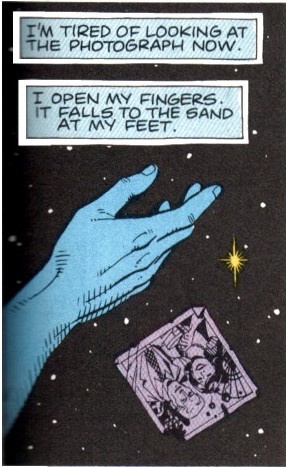 A similar temporal ambivalence exists in the previously discussed description of how his “nostalgia for the [superhero] genre cracked and shattered somewhere along the way and all the sweet old musk inside just leaked out and evaporated,” a statement in which Moore is clearly lying, albeit as much to himself as the reader, the description of the “sweet old musk” evoking precisely what he says he has lost, so that the sentence offers the very experience it exists to reject. Moore casts superheroes away, but in doing so only draws them back in, a tension implicit in the very idea of nostalgia, which is of course an intense feeling for a thing that one is not actually experiencing at the time. He is nostalgic for his nostalgia, relishing in the scent of its memory even as he pushes the genre away, grimly certain in the necessity of all his burnt bridges.…
A similar temporal ambivalence exists in the previously discussed description of how his “nostalgia for the [superhero] genre cracked and shattered somewhere along the way and all the sweet old musk inside just leaked out and evaporated,” a statement in which Moore is clearly lying, albeit as much to himself as the reader, the description of the “sweet old musk” evoking precisely what he says he has lost, so that the sentence offers the very experience it exists to reject. Moore casts superheroes away, but in doing so only draws them back in, a tension implicit in the very idea of nostalgia, which is of course an intense feeling for a thing that one is not actually experiencing at the time. He is nostalgic for his nostalgia, relishing in the scent of its memory even as he pushes the genre away, grimly certain in the necessity of all his burnt bridges.…